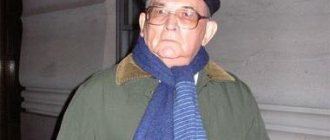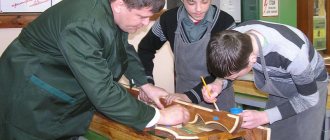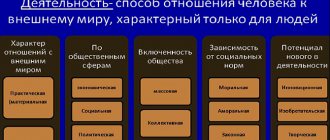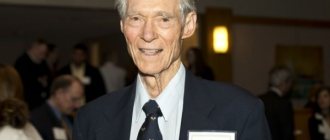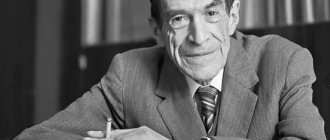Activity is an integral part of human life. From birth, he learns to interact with the world around him. All people go through a complex journey of learning and development, which is an active activity. It is unlikely that everyone thinks about this, because human activity is so natural and automated that attention is simply not fixed on it. But in fact, activity is a rather complex and interesting process, which has its own structure and logic.
History of creation and main provisions of the concept
S. L. Rubinstein and A. N. Leontyev created the theory of activity in the 30s of the twentieth century. They developed this concept in parallel, without discussing or consulting with each other. Nevertheless, their works turned out to have a lot in common, since scientists used the same sources when developing psychological theory. The founders relied on the work of the talented Soviet thinker L. S. Vygotsky, and the philosophical theory of Karl Marx was also used to create the concept.
The main thesis of A. N. Leontiev’s theory of activity briefly sounds like this: it is not consciousness that shapes activity, but activity that shapes consciousness.
In the 30s, on the basis of this position, Sergei Leonidovich defines the main position of the concept, which is based on the close relationship of consciousness and activity. This means that the human psyche is formed during activity and in the process of work, and it manifests itself in them. Scientists have pointed out that it is important to understand the following: consciousness and activity form a unity that has an organic basis. Alexey Nikolaevich emphasized that this connection should in no case be confused with identity, otherwise all the provisions that take place in the theory lose their force.
So, according to A. N. Leontyev, “activity - personal consciousness” is the main logical relationship of the entire concept.
The basic principle
Photo by Laura Tancredi: Pexels
The principle of the unity of consciousness and activity, as presented by Rubinstein, has the following formulation: “The subject in his actions is not only revealed and manifested; it is created and determined in them. Those that he does can define what he is; the direction of his activity can determine and shape him.”
In other words, the psyche and consciousness of an individual is formed in activity, and is manifested in activity. Thus, the identity of human activity and consciousness was established. Consciousness, according to Rubinstein’s presentation, is not given for introspection.
It manifests itself through the interaction of the subject, in this case through activity, and is cognized in it. Activity is considered as a set of actions that are aimed at achieving a goal.
Basic psychological phenomena of the activity theory of A. N. Leontiev and S. L. Rubinstein
Each person unconsciously reacts to an external stimulus with a set of reflex reactions, but activity is not one of these stimuli, since it is regulated by the mental work of the individual. Philosophers in their presented theory consider consciousness as a certain reality that is not intended for human introspection. It can only manifest itself through a system of subjective relations, in particular, through the activities of the individual, during which he manages to develop.
Alexey Nikolaevich Leontyev clarifies the provisions voiced by his colleague. He says that the human psyche is built into his activity, it is formed thanks to it and manifests itself in activity, which ultimately leads to a close connection between the two concepts.
Personality in the theory of activity of A. N. Leontiev is considered in unity with action, work, motive, goal, task, operation, need and emotions.
The concept of activity of A. N. Leontyev and S. L. Rubinstein is a whole system that includes methodological and theoretical principles that allow the study of human psychological phenomena. The concept of activity by A. N. Leontyev contains such a provision that the main subject that helps to study the processes of consciousness is activity. This research approach began to take shape in the psychology of the Soviet Union in the 20s of the twentieth century. In 1930, two interpretations of activity were already proposed. The first position belongs to Sergei Leonidovich, who formulated the principle of unity given above in the article. The second formulation was described by Alexey Nikolaevich together with representatives of the Kharkov psychological school, who identified a common structure affecting external and internal activities.
Leontiev's theory of activity: basic theoretical principles
The problem of activity was studied in detail by the domestic scientist and psychologist A. N. Leontyev back in the middle of the last century. At that time there were no clear ideas about the functioning of the human psyche, and Leontiev turned his close attention to the process of human life. He was interested in how the process of reflecting reality in the human psyche occurs, and how this process is related to specific human activities. Leontiev's theory of activity can be briefly and clearly formulated as follows: activity determines consciousness.
In the process of his theoretical and practical research, Leontiev touches on the most important theoretical issues of psychology, which relate to the emergence and structure of the human psyche, as well as issues related to the study of the psyche. As a result, he came to the following conclusions:
- the study of a person’s practical activity allows us to comprehend the patterns of his mental activity, and vice versa;
- managing the organization of human practical activity allows you to manage the organization of people’s mental activity.
The main provisions of Leontiev's theory:
- Psychology is a science that studies the emergence, work and structure of the mental reflection of reality, which mediates the life of people.
- A mental criterion independent of a person’s subjective opinion is the body’s ability to respond to biologically neutral influences that signal biologically significant stimuli (irritability and sensitivity).
- In evolutionary development, the psyche goes through three stages of change: the stage of the elementary (sensory) psyche, the stage of the perceptual psyche, and the stage of intelligence.
- The psyche of animals develops in the process of activity. The characteristic features of animal life include: the attachment of animal activity to biological models; limitation of actions within the framework of visual situations; animal behavior is regulated by hereditary species programs; learning ability is only the result of an individual’s adaptation to specific conditions of existence; The animal world is not characterized by the consolidation, accumulation and transmission of experience in material form, i.e. there is no material culture.
- Activity is the process of interaction of a living being with the surrounding world in order to satisfy vital needs.
- The activity of the subject is characterized by the implementation of real connections with the objective world. In turn, the objective world mediates subject-object connections.
- Human life activity is objective and has social conditioning. Human actions are inextricably linked with the system of social relations and social conditions. Their main characteristics: objectivity, activity, purposefulness.
- Consciousness is included in the activity of the subject; in itself it cannot be considered. The essence of Leontiev's theory lies in the significant influence of activity on the formation and development of the psyche at different stages of human development. Therefore, actions and behavior are considered included in the consciousness of a person.
Activity structure
In the 30s of the twentieth century, in the psychological school A. N. Leontiev put forward the idea of the need to build a structure of activity in order to make the definition of this concept complete.
Activity structure:
| Number | Start of the chain | End of the chain |
| 1 / 3 | Activity | Motive (usually the subject of need) |
| 2 / 2 | Action | Target |
| 3 / 1 | Operation | Task (under certain conditions becomes a goal) |
This scheme is valid when reading both from top to bottom and vice versa.
There are two forms of activity:
- external;
- internal.
External activities
External activity includes various forms that are expressed in objective and practical activity. With this type, there is an interaction between subjects and objects, the latter being openly presented for external observation. Examples of this form of activity are:
- the work of mechanics using tools - this can be driving nails with a hammer or tightening bolts with a screwdriver;
- production of material objects by specialists on machines;
- children's games that require extraneous things;
- cleaning the premises: sweeping floors with a broom, wiping windows with a rag, manipulating pieces of furniture;
- construction of houses by workers: laying bricks, laying foundations, inserting windows and doors, etc.
Work, incentive, goal, task
Labor as a type of activity is the main feature of a person, and activity acts, in this vein, as a dynamic system of his interaction with the world.
This interaction allows the subject to realize the relationship with the surrounding reality, against the background of which a mental image appears, embodied in the object. Activity basically has motivating reasons that direct the subject to achieve the goal.
The stimulus that causes the activity of a subject and determines the direction of his activity, under the influence of external and internal factors, is a motive. The motive determines the goals and objectives of any activity.
The goal creates an image of the result towards which human activity is directed. A task includes the goal of an activity, which is set under certain conditions. It is resolved by the subject by using and changing specified conditions according to a certain algorithm. The task acts as a given environment for the development of the individual’s activity itself.
Photo by Christina Morillo from Pexels
Internal activities
Internal activity differs in that the subject’s interactions with any images of objects are hidden from direct observation. Examples of this type are:
- solution of a mathematical problem by a scientist using mental activity inaccessible to the eye;
- the actor’s internal work on the role, which includes thinking, worrying, anxiety, etc.;
- the process of creating a work by poets or writers;
- coming up with a script for a school play;
- mental guessing of a riddle by a child;
- emotions evoked in a person when watching a touching film or listening to soulful music.
Motive
The general psychological theory of activity by A. N. Leontyev and S. L. Rubinstein defines a motive as an object of human need; it turns out that in order to characterize this term, it is necessary to turn to the needs of the subject.
In psychology, a motive is the engine of any existing activity, that is, it is a push that brings a subject into an active state, or a goal for which a person is ready to do something.
Needs
The need for a general theory of activity A.N. Leontyev and S.L. Rubinstein has two transcripts:
- Need is a kind of “internal condition”, which is a mandatory prerequisite for any activity performed by the subject. But Aleksey Nikolaevich points out that this type of need is not capable of causing directed activity in any case, because its main goal becomes orientation-research activity, which, as a rule, is aimed at searching for such objects that would be able to save a person from what he is experiencing desires. Sergei Leonidovich adds that this concept is a “virtual need”, which is expressed only within oneself, so a person experiences it in his state or feeling of “incompleteness”.
- Need is the engine of any activity of the subject, which directs and regulates it in the material world after a person meets an object. This term is characterized as an “actual need”, that is, the need for a specific thing at a certain point in time.
Internal and external actions
Leontiev's theory of activity is a psychological phenomenon that illuminates two aspects of life: the explanatory principle and the subject of research. The explanatory principle studies the connection between a person’s individual life and the socio-historical and spiritual life of society. As a result, the following categories were identified: joint and individual activities. Purposeful, transformative, sensory-objective and spiritual characteristics of activity were also identified.
Leontiev's theory characterizes external activity as material, and internal activity as operating with images and ideas about objects. Internal activity has the same structure as external activity, the only difference is in the form of its occurrence. Internal actions are performed with images of objects, ultimately producing a mental result.
As a result of the internalization of external activity, its structure does not change, but is greatly transformed and reduced for its faster implementation in the internal plane. This allows a person to significantly save his efforts and quickly select the necessary actions. However, to successfully reproduce an action in the mind, you first need to master it in the material plane, obtaining a real result. What is very well observed in the process of children’s development: first, they learn to operate and perform the necessary actions with real objects, gradually learning to mentally calculate their actions and achieve the desired result much faster.
"Objectified" need
This concept can be traced using the example of a newly born gosling, which has not yet encountered any specific object, but its properties are already recorded in the mind of the chick - they were passed on to it from its mother in the most general form at the genetic level, so it does not have a desire follow any thing that appears before his eyes at the moment of hatching from the egg. This happens only during the meeting of the gosling, which has its own need, with an object, because it does not yet have a formed idea of the appearance of its desire in the material world. This thing in the chick's subconscious mind fits the scheme of a genetically fixed approximate image, so it is able to satisfy the need of the gosling. This is how a given object that fits the required characteristics is captured as an object that satisfies the corresponding needs, and the need takes on an “objective” form. This is how a suitable thing becomes a motive for a certain activity of the subject: in this case, in the subsequent time, the chick will follow its “objectified” need everywhere.
Thus, Aleksey Nikolaevich and Sergey Leonidovich mean that the need at the very first stage of its formation is not such, it is, at the beginning of its development, the body’s need for something, which is outside the subject’s body, despite the fact that it is reflected on his mental level.
Differences between purpose and motive
Alexey Nikolaevich introduces the concept of “goal” as a desired result that arises in the process of a person planning any activity. He emphasizes that motive is different from this term because it is what something is done for. The goal is what is planned to be done to realize the motive.
As reality shows, in everyday life the terms given above in the article never coincide, but are complementary to each other. Also, it should be understood that there is a certain connection between motive and goal, so they are dependent on each other.
A person always understands what the purpose of the actions he performs or contemplates is, that is, his task is conscious. It turns out that a person always knows exactly what he is going to do. Example: applying to a university, passing pre-selected entrance exams, etc.
The motive in almost all cases is unconscious or unconscious for the subject. That is, a person may not even be aware of the main reasons for performing any activity. Example: an applicant very much wants to apply to a particular institute - he explains this by the fact that the profile of this educational institution coincides with his interests and desired future profession, in fact, the main reason for choosing this university is the desire to be close to the girl he loves, who studies at this university.
Emotions
Analysis of the emotional life of the subject is a direction that is considered leading in the theory of activity of A. N. Leontiev and S. L. Rubinstein.
Emotions are a person’s direct experience of the meaning of a goal (a motive can also be considered the subject of emotions, because on a subconscious level it is defined as a subjective form of an existing goal, behind which it is internally manifested in the individual’s psyche).
Emotions allow a person to understand what the true motives of his behavior and activities actually are. If a person achieves his goal, but does not experience the desired satisfaction from it, that is, on the contrary, negative emotions arise, this means that the motive was not realized. Therefore, the success that an individual has achieved is actually imaginary, because that for which all the activity was undertaken has not been achieved. Example: an applicant entered the institute where his beloved is studying, but she was expelled a week before, which devalues the success that the young man has achieved.
Yu.B. Gippenreiter. Psychological theory of activity. [Operational side of activity] Added by Psychology OnLine.Net 05/11/2008 (Edit 05/11/2008) We are beginning to get acquainted with the “psychological theory of activity”. This theory was created in Soviet psychology and has been developing for more than 50 years. It is indebted to the work of Soviet psychologists: L. S. Vygotsky, S. L. Rubinstein, A. N. Leontiev, A. R. Luria, A. V. Zaporozhets, P. Ya. Galperin and many others. The psychological theory of activity began to be developed in the 20s and early 30s. By this time, the sun had already set on the psychology of consciousness and new foreign theories were in their heyday - behaviorism, psychoanalysis, Gestalt psychology and a number of others. Thus, Soviet psychologists could already take into account the positive aspects and disadvantages of each of these theories. But the main thing was that the authors of the theory of activity adopted the philosophy of dialectical materialism - the theory of K. Marx, and above all its main thesis for psychology that it is not consciousness that determines being and activity, but, on the contrary, being and activity of a person determine his consciousness. This general philosophical thesis found a concrete psychological development in the theory of activity. The theory of activity is most fully presented in the works of A. N. Leontiev, in particular in his last book “Activity. Consciousness. Personality,” and I will stick mainly to his version of this theory. But first I’ll say about Alexei Nikolaevich Leontiev himself (1903 - 1979). As a professional psychologist, A. N. Leontiev worked for 55 years (after graduating from the Department of Social Sciences at Moscow University in 1924) and the last 30 of them at Moscow University as head of the department, head of the department of psychology and, finally, as dean of the faculty of psychology. Almost all psychologists who received their education within the walls of our university in the 50s and 70s. had the opportunity to directly study with this outstanding scientist and teacher: he taught the main course “General Psychology”. As a scientist, A. N. Leontiev was distinguished by extremely broad interests, combining this breadth with the ability to deeply and originally develop every topic to which he addressed. It is difficult to name an area of general psychology to which A. N. Leontiev would not make a tangible and even fundamental contribution. In his works they found developments: general psychological theory of activity; problems of mental development in phylo-, anthropo- and ontogenesis; mechanisms of mental processes - perception, attention, memory, thinking; problems of human consciousness, personality and much more. In studying these problems, A. N. Leontiev worked not only as an outstanding theorist and methodologist, but also as a brilliant experimenter. He loved and knew how to work with his hands, he himself designed experimental setups, came up with original methods, knew how to appreciate beautiful facts and had an inspiring emotional attitude towards them. On the contrary, he always encountered internal resistance to boring and cumbersome research. Everyone who worked with A. N. Leontiev at the faculty he headed, daily encountered another side of his multifaceted personality - his organizational abilities. An intelligent and experienced leader, he, despite everyday little things (and there were always so many of them!), was able to identify the main strategic lines of development of the faculty and psychological science as a whole and constantly took care of it. He foresaw the future very well and knew what to do for it today. It was thanks to this ability that the relatively small department of general psychology at the Faculty of Philosophy, which A. N. Leontiev headed in 1949, turned into an independent faculty. Finally, a few words about A. N. Leontiev as a teacher. His lectures were distinguished by the same depth, sharpness and emotionality as his scientific work. He took a very personal approach to everything he taught; he dramatized the presentation of each topic and forced listeners to think hard. All those who were lucky enough to be A. N. Leontiev’s direct students forever remembered their many hours of conversations with him. The occasion was usually a current experimental study, but very soon the conversation went beyond the scope of this specific topic under discussion - into the area of global psychological and life problems. And here A. N. Leontyev generously shared his ideas, experiences and relationships, his vast scientific and human experience. That is why he was and remains a teacher with a capital T for many of us. Now let's turn to activity theory. I'll start with a description of the structure, or macrostructure, of activity. Ideas about the structure of activity, although they do not completely exhaust the theory of activity, form its basis. Later, and especially in subsequent lectures, you will become familiar with the application of activity theory to the solution of fundamental psychological problems, such as the subject of psychology, the origin and development of the psyche in phylo- and ontogenesis, the origin of human consciousness, the nature of personality, etc. Human activity has a complex hierarchical structure . It consists of several “layers” or levels. Let's name these levels, moving from top to bottom. This is, firstly, the level of special activities (or special types of activities); then the action level; the next is the level of operations; finally, the lowest is the level of psychophysiological functions. In this lecture we will begin to consider the structure of activity from the level of actions and will move down to psychophysiological functions. We will leave the upward movement to special types of activities and related problems for next time. Action
is the basic unit of performance analysis.
What is action? By definition, action is a process aimed at realizing a goal. Thus, the definition of action includes another concept that needs to be defined - goal
.
What is a goal? This is an image of the desired result, i.e. the result that should be achieved during the execution of the action. It is worth noting right away that what is meant here is a conscious image of the result: the latter is retained in consciousness the entire time the action is carried out, so talking about a “conscious goal” does not make much sense: the goal is always conscious. Let's ask ourselves the question: is it possible to do something without imagining the end result? Of course you can. For example, “wandering aimlessly through the streets,” a person may find himself in an unfamiliar part of the city. He does not know how and where he got to, and this means that in his mind there was no final point of movement, i.e., his goal. However, a person’s aimless activity is more an artifact of his life activity than its typical manifestation. Since action, as I have already said, is the main unit of analysis of a person’s mental life, proposed by the theory of activity, it is necessary to more carefully consider the main features of this unit. This will help to better understand both the very spirit of activity theory and its differences from previous theories. Characterizing the concept of “action”, we can highlight the following four points. The first point: action includes as a necessary component an act of consciousness (as discussed above) in the form of setting and maintaining a goal. But this act of consciousness is not closed in itself, as the psychology of consciousness actually asserted, but “reveals” in action. The second point: action is at the same time an act of behavior. Consequently, the theory of activity also preserves the achievements of behaviorism, making the external activity of animals and humans the object of study. However, unlike behaviorism, it considers external movements in inextricable unity with consciousness. After all, movement without a goal is more likely a failed behavior than its true essence. So, the first two points on which the theory of activity differs from previous concepts are the recognition of the inextricable unity of consciousness and behavior. This unity is already contained in the main unit of analysis - action. The third, very important point: through the concept of action, the theory of activity affirms the principle of activity, contrasting it with the principle of reactivity. The principle of activity and the principle of reactivity differ in where, according to each of them, the starting point of activity analysis should be placed: in the external environment or inside the organism (subject). As you remember, for J. Watson the main thing was the concept of reaction. Reaction means “response action” (lat. re... - against + actio - action). The active, initiating principle here belongs to the stimulus. You already know that Watson considered it possible to describe all human behavior through a system of reactions (even very complex ones). But such hopes began to be immediately dashed by facts that showed that many behavioral acts or actions could not be explained based solely on an analysis of external conditions (stimuli). It is too typical for a person to act in a way that obeys not the logic of external influences, but the logic of his internal goal. These are not so much reactions to external stimuli as actions aimed at achieving a goal, taking into account external conditions. And here it is appropriate to recall the words of K. Marx that for a person, a goal “like a law determines the method and nature of his actions” [1, vol. 3, p. 189]. So, through the concept of action, which presupposes an active principle in the subject (in the form of a goal), the psychological theory of activity affirms the principle of activity. And finally, fourth: the concept of action “brings” human activity into the objective and social world. The fact is that the “imagined result” (goal) of an action can be anything, and not only and not even so much biological, such as, for example, obtaining food, avoiding danger, etc. It can be the production of some kind of material product, establishing social contact, acquiring knowledge, etc. Thus, the concept of action makes it possible to approach human life with scientific analysis precisely from the side of its human specificity. Such a possibility could not be provided by the concept of reaction, especially the innate reaction, from which J. Watson proceeded. Man, through the prism of Watson’s system, acted primarily as a biological being. So, you have become acquainted with the concept of action - one of the main “formative” activities. This concept, like a drop of water, reflects the basic starting points or principles of the theory of activity, new in comparison with previous concepts. Let's repeat them again. 1. Consciousness cannot be considered as closed in itself: it must be brought into the activity of the subject (“opening” the circle of consciousness). 2. Behavior cannot be considered in isolation from a person’s consciousness. When considering behavior, consciousness must not only be preserved, but also defined in its fundamental function (the principle of the unity of consciousness and behavior). 3.Activity is an active, purposeful process (principle of activity). 4.Human actions are objective; they realize social—production and cultural—goals (the principle of the objectivity of human activity and the principle of its social conditionality). Further these basic provisions will be revealed and filled with content, but I wanted to take this opportunity and show you how all these rather complex provisions are contained, in essence, already in one concept “action”. So, let's return to the connection goal - action (C-D). The goal sets the action, the action ensures the realization of the goal. By characterizing the goal, you can also characterize the action. What can be noted when analyzing a person’s goals? First of all, their extreme diversity, and most importantly, their different scales. There are large goals that are divided into smaller, private goals, which, in turn, can be divided into even more private goals, etc. Accordingly, any sufficiently large action is a sequence of actions of a lower order with transitions to different “floors” hierarchical system of actions. This can be demonstrated using any example. Let's say you want to call another city. To carry out this action (I order), you need to perform a number of private actions (II order): go to a telephone exchange point, find a suitable machine (if there is an automatic connection with your city), take a turn, purchase telephone tokens, etc. Getting there into the booth, you must perform the following action in this row: connect to the subscriber. But to do this, you will have to perform a series of even smaller actions (III order): put in a coin, press a button, wait for the beep, dial a certain number, etc. As another example of describing a sequence of private actions, I will give a short excerpt from E. Hemingway’s story “ On Big River." This is one of the writer's early stories, written in a very interesting style. You will feel it now. It tells the story of how a young man (apparently the author himself) spends his vacation on the river, where he lives alone and fishes for trout. “Nick took an empty bottle and went down to the river <...> Nick wanted to catch grasshoppers for bait before the sun dried the grass. <…> He turned over a fallen tree, and there, under cover, grasshoppers sat in the hundreds. This was their home. Nick collected at least fifty medium-sized brown ones into the bottle <…> Nick rolled the log to its original place <…> Nick leaned the bottle full of jumping grasshoppers against a pine tree. He quickly mixed a little buckwheat flour with water, a cup of flour to a cup of water, and kneaded the dough. He poured a handful of coffee into the pot, took a piece of lard from the can and threw it into the hot frying pan. Then he carefully poured the dough into the sizzling lard... Nick took a clean pine chip and slipped it under the cake, already browned on the bottom, he shook the pan and the cake separated from the bottom. “Just don’t break it,” thought Nick. He slipped the wood chip as far under the cake as possible and turned it over to the other side. She hissed. <…> Nick took his spinning rod out of its leather case, unscrewed the rod, and put the case back into the tent. He put on the reel and began to wind the line onto it. At the same time, the forest had to be intercepted from hand to hand, otherwise it would unwind from its own weight” [125, p. 128 - 129]. You see, the entire story (I chose random excerpts) is written in a special style, namely: it looks through the lens of time, as if through the lens of time, to examine the hero’s sequential actions, including the smallest ones. Apparently, using this technique, E. Hemingway solves a special artistic problem - to reflect the atmosphere of peace, serene relaxation and the pleasure that the hero experiences while experiencing every minor event. For us, this story well illustrates the theoretical position that activity is a sequence of actions, each of which can be divided into actions of a lower order. I present to you the opportunity to figure out for yourself what actions, in what sequence and in what hierarchical subordination you must perform in order to take a walk outside the city, prepare a report for a seminar, publish a wall newspaper, etc. Speaking about complex component actions, it should be noted that a specific set and sequence of private actions are dictated by the logic of the social and subject environment. In fact, in order to catch grasshoppers, you must take into account their lifestyle and behavior. If you do not correlate your actions with the pay phone device, you will never contact the subscription. The release of a wall newspaper also involves a certain range of mandatory actions. Experience regarding the composition and sequence of actions is usually transmitted during training in the form of rules, advice, instructions, and programs. You have probably already encountered one case of transferring such experience in the first week of classes at the faculty, when you were introduced to the rules for searching and obtaining the desired book from the library. Everything that has been said so far has related to what a person does. Now let's move on to discussing how, in what way the action is performed. Accordingly, we turn to operations that form the next, lower level in relation to actions. By definition, an operation is a way of performing an action. Let me give you a few simple examples. You can multiply two two-digit numbers in your head and in writing by solving the example “in a column.” These will be two different ways of performing the same arithmetic operation, or two different operations. They say that the women's way of threading a needle is that the thread is pushed into the eye of the needle, and men supposedly push the eye onto the thread. These are also different operations, in this case motor ones. Another example: you want to find a certain place in a book, but you discover that the bookmark you previously placed has fallen out. You are forced to resort to another way of finding the required paragraph: either try to remember the page number, or, while flipping through the book, skim each page with your eyes, etc. Again, several different ways to achieve the same goal. As you can see, operations characterize the technical side of performing actions, and what is called “technique,” dexterity, dexterity, refers almost exclusively to the level of operations. What determines the nature of the operations used? The generalized answer is: from the conditions in which the action is performed. If the action meets the goal itself, then the operation meets the conditions under which this goal is given. In this case, “conditions” mean both external circumstances and the possibilities, or internal means, of the acting subject himself. A goal given under certain conditions in activity theory is called a task. When describing the process of solving a problem, it is necessary to indicate both the actions and operations that implement them. It is possible to talk about action without operations, or about action abstracted from operations, perhaps only at the planning stage. <…> Let's move on to the psychological characteristics of operations. Their main property is that they are little or not realized at all. In this way, operations are fundamentally different from actions that require both a conscious goal and conscious control over the course of the action. Essentially, the operations layer is filled with automatic actions and skills you already know. The characteristics of the latter are at the same time the characteristics of operations. Let us reproduce a number of provisions known to us, only in the new language proposed by the theory of activity. There are two types of operations: some arise through adaptation, adjustment, and direct imitation; others arise from actions by automating them. This is the first thesis. The second thesis: operations of the first kind are practically not realized and cannot be evoked in consciousness even with special efforts. Operations of the second kind are on the border of consciousness. They are, as it were, guarded by consciousness and can easily become actually conscious. The third thesis: every complex action consists of a layer of actions and a layer of “underlying” operations. What was said regarding the non-fixity of the border that passes in every complex action between the actually conscious and the unconscious means the mobility of the border, which separates the layer of actions from the layer of operations. The upward movement of this boundary means the transformation of some actions (mostly the most elementary ones) into operations. In such cases, units of activity are consolidated. Moving the boundary down means, on the contrary, the transformation of operations into actions, or, what is the same, the fragmentation of activities into smaller units. Let's look at an example. Suppose that in the course of a discussion one thought occurred to you and you expressed it, caring mainly about its content and not about the method of expression. You performed an action that was supported by many operations - mental, speech, articulation, etc. All together they realized the action - the expression of a thought. But let’s assume that you couldn’t immediately find the right word to express your thought. Then you put effort into searching for it and finally find it. What used to happen at the level of operations (choice of words) has become action: the boundary has moved down. But suppose again that when you uttered the word you made a reservation; then you repeat this word, making sure to pronounce it correctly. An action has become an even smaller act - the actual articulation of a word, which, as a rule, lies in the deep layers of operations. In other words, the boundary separating actions from operations has descended even lower. Probably, each of you observed the opposite dynamic when learning a foreign language: at the very beginning of learning, pronouncing a single word and even a single sound is a small but independent action; at the stage of fluent language proficiency, almost all phonetic, lexical and grammatical problems are solved at the level of operations. Now you can rightly ask: how can one find out where in each specific case, at each given moment, the boundary separating action from operations lies? This question is very important. Since an action is a unit of activity, the answer to it will allow us to establish what units a person is currently working with. The latter is significant not only in theoretical, but also in practical terms, since it makes it possible to find out how much a person has progressed in learning, how much and what his consciousness is “loaded” with, whether he is in a state of fatigue or emotional arousal (in which fragmentation of actions occurs ). Despite the extreme importance of the question posed, psychology has not yet found an answer to it, and it is one of the problems of current experimental research. Why experimental research? Because it is speculatively impossible to answer. In fact, here it is impossible to use the theoretical features that are contained in the definitions of actions and operations. For example, defining an operation as a way of performing an action does not “work” in this case, because the converse statement is not true: not every way is an operation. Thus, private actions may well be considered as ways of performing a larger action of which they are part, but at the same time they do not cease to be actions. Let's look at examples that are already familiar to us. You can call another city in different ways: by dialing an automatic number or ordering a conversation through a telephone operator. Each of these options will be a way to carry out a larger action, the purpose of which is to contact the subscriber. Each of these methods will meet conditions: for example, if there is no home telephone, you have to go to a telephone exchange, etc. These are all the conditions in which the action takes place. So it seems that everything is suitable for defining dialing an area code or contacting a telephone operator as an operation. Nevertheless, these will be actions, albeit private, subordinated to a more common goal, but quite consciously planned and consciously controlled actions. Another example: a very small action that is described in the cited story of E. Hemingway,- turning the cake. If you remember, this process is described with great details that include randing ramp, shaking the pans, promotion of the beam further, etc. Of course, the techniques of turning the tortillas well deserve only the rank of operations and, as a rule, are such. But in this case, it is shown that for the hero of the story, each of these smallest acts acts as a separate, independent action. And if you doubt this, then I will notice that at least for the writer himself these acts existed as conscious actions, otherwise he could not describe them, and even so relief and vividly. So, neither the status of a “method”, nor correlation with conditions, nor the value, or the scale of the act, of course, allow to determine its activity rank, that is, to answer the question whether it is an action or an operation. The most accurate psychological feature that distinguishes actions and operations - awareness/unconsciousness, in principle, can be used, however, far from always. He stops working just in the border zone, near the border, which shares a layer of actions and operations. The farther from this border, the more reliable the data of self-observation: relative to the pre-state (or inappropriation) in the minds of very large or very small acts, the subject usually does not doubt. But in the border zone there is a significant situational dynamics of the activity process. And here, an attempt to determine the awareness of any act can already lead to its awareness, that is, to violate the natural structure of activity. The only way that is now seen is the use of objective indicators, that is, behavioral and physiological features, the active level of the current process. Attempts by this kind already exist [see 53, p. 111]. Let's move on to the last, lowest level in the structure of activity - psychophysiological functions
.
Speaking that the subject carries out activities, we must not forget that this subject is both an organism with a highly organized nervous system, developed sensory organs, a complex musculoskeletal system, etc., in essence, psychology never forgot about it, did not forget about it, But she could not organically include the functioning of brain mechanisms in mental activity. This work was considered, for example, V. Wundt in parallel with the analysis of the processes of consciousness. Psychophysiological functions in the theory of activity are understood as the physiological support of mental processes. These include a number of abilities of our body, such as the ability to feel, the formation and fixation of traces of past influences, motor power, etc. Accordingly they speak of sensory, memic, motor functions. This level also includes congenital mechanisms fixed in the morphology of the nervous system, and those that ripen during the first months of life. It is clear that the border between automatic operations and psychophysiological functions is quite arbitrary, and here the same difficulty of a clear separation of neighboring levels that we met in the discussion of the attitude of operations and actions is repeated. However, despite this, psychophysiological functions are distinguished into an independent level due to their “organismic” nature. They go to the subject of activity, so to speak, from nature; He must “do” anything to have them, he finds them in himself ready for use. How do psychophysiological functions “fit” into activity? We can say that they make up both the necessary prerequisites and means of activity. Take the memory for example. When a person sets himself the goal of remembering something, he often uses special techniques, or actions called mnemonic, sometimes it is a logical analysis of the material, sometimes association with something well-known, sometimes just repetition. But none of these actions would lead to the desired result if the subject had not had a mnemonic function. There is a disease of memory called the “Korsakovsky syndrome” (by the name of the outstanding Russian psychiatrist S. S. Korsakov, who first described it). It consists in the loss of a mnemonic function. With this disease, events are not remembered at all, even those that happened a few minutes ago. Such patients can, for example, say hello several times a day, do not remember whether they ate today or not. One patient continuously read out his mother he liked in the book, immediately forgetting that he had just read him, and so he repeated dozens of times in a row. It is obvious that if such a patient tried to specially memorize any text, then he would immediately forget not only this text, but the very fact of memorization. So, we can say that psychophysiological functions constitute an organic foundation of the processes of activity. Without support, they would not only be performed by actions and operations, but also setting the tasks themselves. On this, I finish the characteristics of three main levels in the structure of activity - actions, operations and psychophysiological functions. The discussion of mainly operational and technical
aspects of activity is associated with these levels. Going from the level of action up, we will meet with another circle of problems that have a much closer attitude to personality problems.
| Description | We begin our acquaintance with the “psychological theory of activity.” This theory was created in Soviet psychology and has been developing for more than 50 years. It is indebted to the work of Soviet psychologists: L. S. Vygotsky, S. L. Rubinstein, A. N. Leontiev, A. R. Luria, A. V. Zaporozhets, P. Ya. Galperin and many others. [Y.B. Gippenreiter. Introduction to general psychology. Section II. Lecture 7] |
| Rating |
3/5 based on 2 votes. Median rating 1. |
| Views | . On average per day. |
| Similar articles | Yu.B. Gippenreiter. Psychological theory of activity. [Motivational aspect] Motivation for learning activities Readiness for activities in psychology The concept of activity and its significance for psychology Klimov E.A. Individual style of activity |
